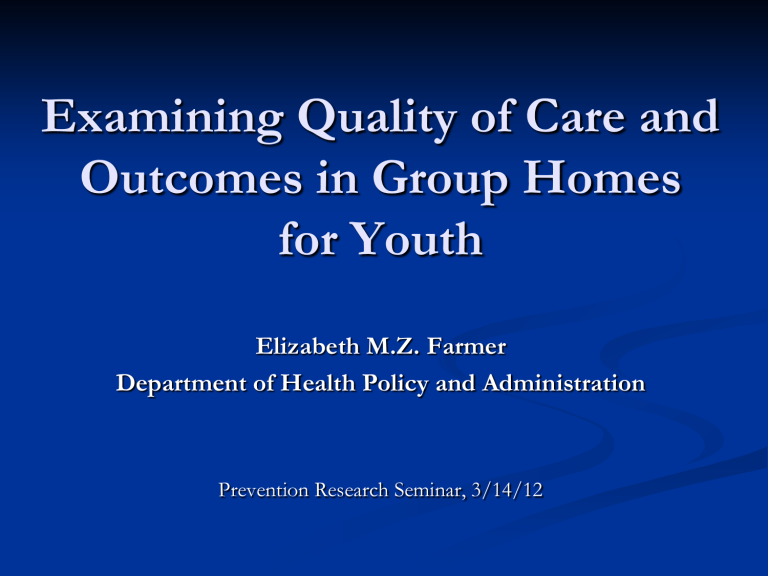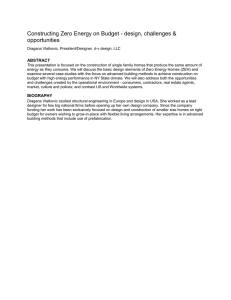Examining Quality of Care and Outcomes in Group Homes for Youth

Examining Quality of Care and
Outcomes in Group Homes for Youth
Elizabeth M.Z. Farmer
Department of Health Policy and Administration
Prevention Research Seminar, 3/14/12
Background and Overview
One of the most commonly used out-ofhome placements for youth with mental health and behavioral problems
Limited Research
Promising literature from 1970s, ‘80s
Teaching Family Model
Sparse literature is mixed
GH’s worse than TFC (Chamberlain)
GH’s better than TFC (Lee)
GH’s and TFC comparable (Farmer)
Problems Created by lack of Research
Little known about what happens in group homes
Quality of care?
Key Processes?
Concerns about effectiveness
Concern regarding potential iatrogenic effects
Highly publicized negative outcomes
No substantial data to influence policy debates
Cost – worth it?
Paradigmatic misfit: focus on least restrictive care
Current Study
2006 – Application to NIMH to study group homes
Argued that policy decisions were/are being made that are not based on data
Adequate data do not exist
Therefore, we need a study to examine whether, how, and under what circumstances group homes can be effective
Funded 2007 - 2012
Specific Aims
Outcomes for youth in group homes
Effects of organizational factors and core processes on outcomes
Rates and predictors of iatrogenic effects
Does adherence to a promising model of group home treatment (i.e., Teaching
Family) produce more positive outcomes for youth?
Study Design
Longitudinal study (14 sites/47 homes/573 youth)
Quasi-experimental (half Teaching Family; half not)
2 year recruiting period
In-person interview with staff and youth (every 4 months)
Phone interview with caregiver or legal guardian (preadmission and post discharge at 4 and 8 months)
Review of youth case record
Observational Interview
Glisson measure (organizational culture/climate)
Director Interviews
The Teaching Family Model
Achievement Place Model
Early 1970s, Univ. of Kansas
Most promising data on group home care
Improvements across time, better outcomes than non-TF group homes, better implementation of key mediators
(adult-child interactions, self-esteem, locus of control, etc.)
Underpinning for Boys Town model
Research in 70s, 80s (BT more recently)
Small n’s, inadequate designs, does not meet current EBP standards
Key Elements of Teaching
Family Model
Family-style living (ideal is a married couple as
Teaching Parents)
Training, consultation, evaluation of Teaching
Parents
24/7 professional consultation
Thorough recurrent evaluation and recertification
Proactive teaching interactions focused on positive prevention and youths’ skill acquisition
Peer leadership/self-governance
Agency Selection and Description
List of all licensed homes in North Carolina
Included all TF-affiliated programs; 1 non-TF program in same catchment area selected randomly
2 or more homes
10 or fewer youth per home
Non-specialized homes
Licensed by DSS or Mental Health
Unlocked campus and community based programs
Referrals to program came from a variety of sources (e.g.,
Juvenile Justice, Mental Health, DSS, family)
Participating Agencies
14 Agencies
7 Teaching Family
7 non-Teaching Family
2-6 Homes per Agency
2-10 kids per home
49% boys, 38% girls, 13% co-ed
Agency Directors
Similar in gender, 57% men
Similar in tenure in position
Race
100% Teaching Family agency directors are white
43% of non-Teaching Family are white
Models
93% of directors report using a model
All Teaching Family directors report using
Teaching Family Model
Models cited by non-Teaching Family directors include behavior modification, “model of care,” cognitive based, Aggression
Replacement Therapy, “try to be a good role model”
Restraint Policies
Allow use of physical restraint:
57% of Teaching Family homes
86% of non-Teaching Family Homes
Campus?
55% Teaching Family homes are campusbased
27% non-Teaching Family homes are campus-based
Service Delivery
Few agencies provide only group home care
86% of Teaching Family agencies provide other services
83% of non-Teaching Family agencies provide other services
TFC and Day Treatment were more commonly offered by Teaching Family than non-Teaching Family
Gender (% female)
Race
African American
Caucasian
Age
Primary Staff
TF
55%
21%
74%
Range = 23-65
Median = 33
Non-TF
57%
69%
25%
Range = 24-57
Median =33
Primary Staff: Education Level
High School
Some College
College Degree
Post-Graduate
TF
15%
18%
61%
5%
Non-TF
25%
32%
39%
4%
Staff Rating:
Overall, how would you rate the staff who work in this home?
Very Good
Pretty Good
Average
Too Mixed to Rate
TF
74%
22%
0%
4%
Non-TF
39%
39%
18%
4%
Youth Demographics
Number of Youth
573 total
371 Teaching Family
202 Non-Teaching Family
Youth Age
Range: 6-20
Average: 14.6
Average Length of Stay
Overall: 328 days (~11 Months)
TF: 331
Non-TF: 323
Youth Demographics
Sex
TF
Non-TF
Race
Overall
TF
Non-TF
Overall
Female
48.5
47.4
48.1
African
American
29.1
38.9
32.5
White
55.0
51.6
53.8
Male
51.5
52.6
51.9
Other
15.9
9.5
13.7
Custody
History of Abuse and Neglect
Type of Agency
TF
Non-TF
Type of
Maltreatment
Physical
Sexual
Emotional
Neglect
Physical
Sexual
Emotional
Neglect
% of Youth
34.4
32.1
16.5
82.1**
49.5*
41.2
18.6
64.9
*p<.05 **p<.001
Lifetime Placement History
68% of youth had at least one previous out-ofhome placement
~ 1/3 of youth in both TF and Non-TF had previous placement of…
Therapeutic or Regular Foster Care
Group Home
Residential Treatment Center
Hospital – 33%* of Non-TF and 22% of TF
Correctional Facility – 17% of TF and 14% non-TF
*significant at p < 0.05
Pre-Admission Placement
Level of Severity at Admission
Total score on Strengths and Difficulties Questionnaire
16 is the cutpoint between medium difficulties and high difficulties in a U.S.- normed sample
Mean for both groups is in the high difficulties range
*TF youth significantly less severe (p<.001)
TF
18.3*
Non-TF
21.8
Overall
19.4
Youth Views
Consumer Questions: Staff Ratings
80
70
60
50
40
30
20
10
0
Fair Staff*
*P<.05
Pleasant Staff Teach You
Relevant Things*
Program
Consistency*
TFA
Non-TF
Home Environment: Peers and Staff
Is someone helping you do the right thing?
Is there anyone who will set you up?
Is there anyone you are afraid will hurt you?
Is there anyone looking out for you so you don’t get hurt?
* p<.01
TF
95.5
38.0
5.2
85.5
% Yes
Non-TF
96.7
28.8*
7.3
86.4
In-Home Observations
The Observation
Completed once in the first year of study
Spent 2-3 hours in each home
Included “home tour,” talking to youth/staff,
“hanging out”, eating dinner, observing free time
Two observers for each observation
Discussed coding and reached consensus within ½ point between coders
Final score for each home is average for each item
Measure adapted (“genericized”) from a Teaching Family observational measure
Domains Included in Observation
Youth Skills
Social skills development; Understanding of program
Staff Teaching Skills
Behavior/modeling; Teaching Skills
Structure and Systems
Decision making; Peer leadership; Motivation system
Home Environment
Atmosphere; Physical Environment; Basic
Structure and safety
Criteria for Rating
5 = Extremely Satisfied
4 = Mostly Satisfied
3 = Slightly Satisfied
2 = Not Satisfied
1 = Extremely Dissatisfied
Greeting skills
Relevance to life
Appropriate humor
Models interpersonal behavior
Recognizes appropriate youth behavior
Pre-teaching
Youth and Staff Skills
TF Average TF Range
4.0 2.5 - 5
Non-TF
Average
2.8
4.1
4.3
4.4
4.0
3.5
2 – 5
3 – 5
3 – 5
2 – 5
2 – 5
2.8
3.4
3.5
2.4
2.4
Non-TF
Range
2 - 4
1 - 5
2 - 5
2 - 5
2 - 5
2 - 4
Structure and Systems, Home
Environment, & Safety
Peer leadership
TF Average TF Range
4.5 2 – 5
Non-TF
Average
1.9
Non-TF
Range
1 - 3
Positively focused motivation system
Access to age-, interestappropriate items
Youth/Staff share meals
4.6
4.3
4.6
3 – 5
3 – 5
2 – 5
2.7
3.4
3.2
1 - 5
2 - 5
2 - 5
Overview of Observations
Overall, TF is higher on nearly all domains than non-
TF
However, substantial variation within both TF and non-TF
Pre-teaching seems under-utilized across homes
The average Structure and Safety scores for both TF and non-TF homes were good
There was a pattern of lower scores in non-TF homes.
This suggests the need for …
additional attention on adult-child interactions opportunities for “normal” development
attention to the nature of the motivation system
A Preliminary Look at
Youth Outcomes
Where to Start……….?
Change across time?
Do kids improve while in group homes?
Predictors and subgroups
For whom? Under what conditions?
ALL very preliminary – what we’ll be working on in the coming year(s)….
17
16
15
14
19
18
Overall pattern across time
(Strength and Difficulties Questionnaire (SDQ)
20
Admission 4 months 8 months 12 months
Change over time: TF vs. non-TF
Youth Characteristics Related to
Change from Admission to 4 months:
Age
Youth Characteristics Related to Changes
During Group Home Stay: Race
100%
90%
80%
70%
60%
50%
40%
30%
20%
10%
0%
23
43
33
36
37
27
Got Better
Stayed Same
Got Worse
White Non-White
Adding Home-level factors: Observations
Home Observation Data
Created 8 scale scores (based on domains)
Highly correlated with each other and with TF
None of the domains were related to change
However, including domains made age becomes significant while in home, too
Older youth do better, when youth skills, staff teaching skills, motivational system, home atmosphere, home environment, home safety taken into account
Potential interaction effects????
Adding Youth Perceptions
Youth perceptions of staff are related to change:
Admission to 4 months:
More improvement if youth view staff as:
Fair (p<.05), help learn things (p<.05), care
(p<.1)
4 to 8 months:
Less significant…
More improvement if youth view staff as:
Fair (p<.1)
Conclusions
We have a lot of work to do
Non-comparable quasi-experimental study
Clear differences among homes
Some related to model
Substantial variation within models
At this point, no quick indicator of “good”
Overall, youth improve in group homes
Picture’s much more complicated than this




